Exploring the Possibilities of Pergolas
A pergola is an outdoor building with an open roof structure. There are usually aluminum pergola and PVC pergola, etc. It may be used for both home and commercial purposes.
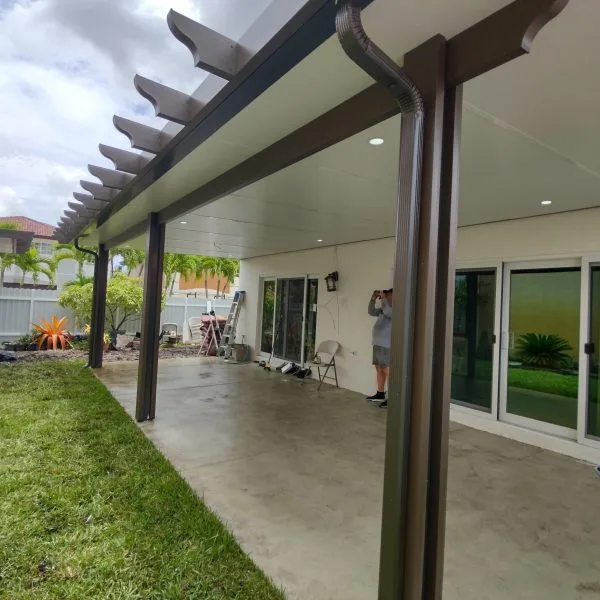
For example, in home usage:
1. barbecue area: a pergola provides an ideal outdoor space for barbecuing and outdoor cooking. You can set up your grill under the pergola and enjoy a meal with your family and friends in a cozy environment.
2. Café: The pergola can create a cozy café area. You can set up tables and chairs under the pergola and enjoy early morning coffee or afternoon tea, creating a pleasant and relaxing atmosphere.
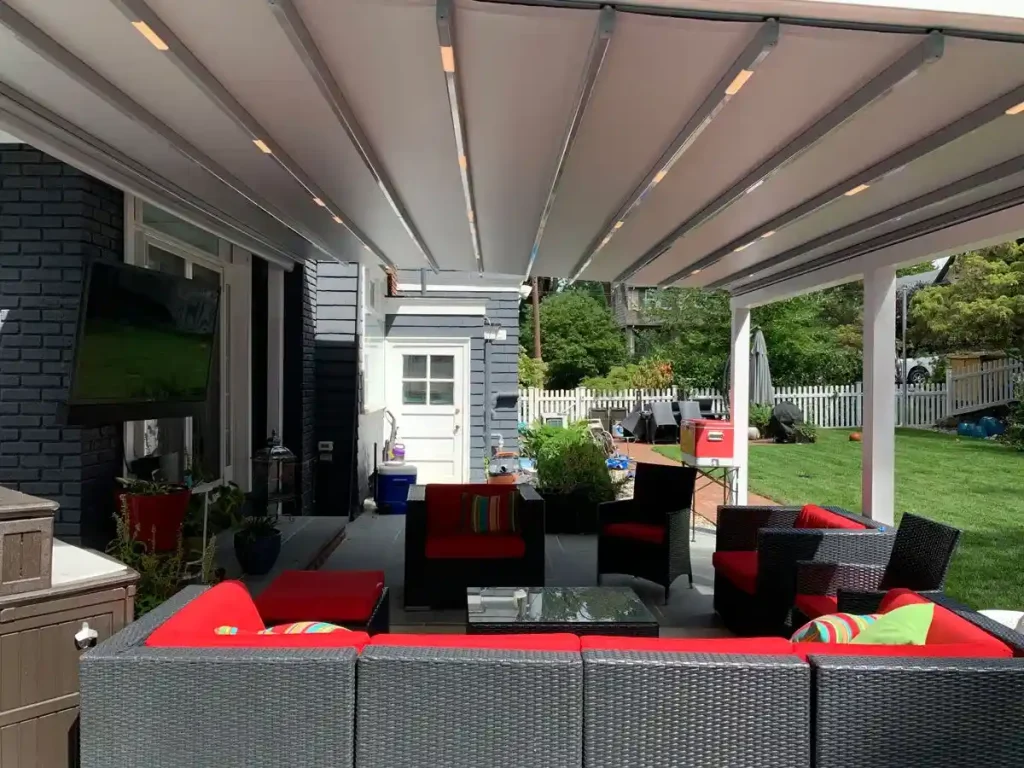
3. Pool Party: The pergola can be used as a shade structure to provide a shady lounge area by the pool. You can place lounge chairs, outdoor furniture, or a lounge area under the pergola for people to relax and socialize after a swim.
A pergola can create a way for you to live closer to the outdoors. It provides you with a shaded outdoor space for a variety of outdoor activities such as reading, lounging, enjoying the garden or playing with your family.
Commercial Uses
1. restaurant terrace: a pergola is often used as an alfresco dining area in restaurants and cafes. It provides a comfortable outdoor environment for diners and creates a special place for businesses to attract customers.
2. Café Lounge: A pergola can be used to create an outdoor café lounge area for customers to enjoy coffee and refreshments outdoors. This environment is often seen as an ideal place to relax and socialize.
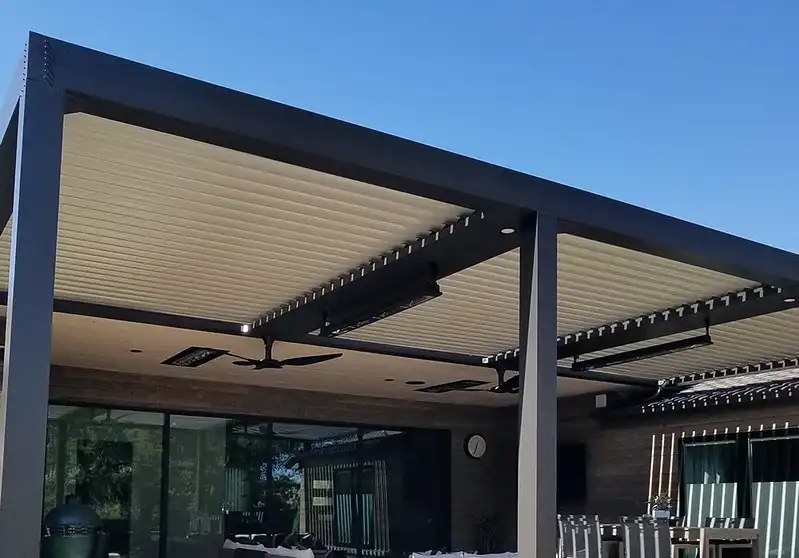
3. hotel courtyard: pergolas can be used to decorate a hotel courtyard or garden, providing guests with an attractive outdoor lounge space suitable for relaxing, reading or socializing.
4. Smoking area: In some commercial establishments, pergolas can be used as a designated smoking area, providing smokers with a comfortable outdoor area while avoiding the effects of smoke on indoor spaces.
Pergolas such as aluminum pergola, provide shade and comfort for outdoor activities, creating an environment close to nature.
Pergola Construction and Materials
Construcción
There are two types of pergolas depending on their construction: free-standing types and building-dependent types, but they all consist of a main body + roof.
1. Main body (columns and beams): The construction of a pergola is usually supported by columns. The columns can be freestanding, fixed to the ground, or dependent on a building or wall.
The crossbeams are horizontal structures that connect the posts and are used to support the roof of the pergola. The spacing of the crossbeams can be determined by personal design and preference and is usually evenly spaced.
2. Roof: The roof structure of a pergola can be chosen according to individual needs. Common roof designs include flat, gabled, triangular and pitched roofs. Roofs can be open to allow sunlight to pass through, or you can choose shading materials, and there are also removable structures that provide both shade and enjoyment of the sun, as will be mentioned later.

In addition to the post + roof structure, pergolas can also have additional decorations and features. Depending on personal preferences and needs, pergolas can add such things as side shelters, curtains, lighting fixtures, and vines and plants for added aesthetics and practicality.
Material Comparison
1.Wooden pergola: Wood is one of the more commonly used pergola materials. Wooden pergolas give a natural, warm feeling and can blend well with the outdoor environment. However, wood has its own disadvantages.
Wooden pergola is more likely to mold and needs regular maintenance and antiseptic treatment to extend its service life and keep it beautiful. The price of wood has a very big price difference according to the type of wood, common wood includes pine, redwood, cedar, etc. You need to carefully screen when shopping for a wooden pergola.

2. PVC or Plastic: Pergolas made of PVC or plastic materials are waterproof and easy to clean. These materials are usually more affordable. They can mimic the look of wood or metal, offering a wide selection of colors and textures.
However, PVC materials may be less suitable in windy and cold temperatures because it may not be strong and durable enough. Because PVC material does not last well outdoors, it is susceptible to sunlight, rain, and snow. After years of use, it may crack, yellow, and become brittle, and needs to be inspected from time to time to ensure safety.
3. Metal: Metal materials such as iron and aluminum are also commonly used in the construction of pergolas. Iron pergolas are usually strong and durable and are suitable for use in situations where more structural support is required.
Aluminum pergola, on the other hand, is lighter, corrosion-resistant, and suitable for use in humid environments such as seashores. Aluminum pergolas are generally chosen for home use because they are lighter in weight, easier to install and less prone to rust, and better maintained than iron pergolas.
Advantages of Aluminum Pergola
Aluminum pergolas are available in different styles and colors, and can also be retrofitted with patio fencing to ensure an integrated and aesthetically pleasing patio. Compared to other materials such as steel, aluminum pergola is much lighter and easier to install and move, and also has enough structural strength in use to withstand outdoor erosion in different climatic conditions.

Furthermore, aluminum has excellent corrosion resistance and is not affected by oxidation, rust or corrosion. This makes aluminum pergolas ideal for outdoor environments, able to withstand wet, humid and changing weather conditions without damage.
Over the long term, aluminum pergolas are the easiest as well as the least expensive to maintain. Because aluminum is inherently weather resistant, aluminum pergolas do not require frequent painting or protective treatments, but only regular cleaning to maintain their appearance and performance, saving time and energy.
Of course the appearance is also a point that everyone pays more attention to when installing a pergola. Aluminum is available in a wide variety of shapes, and aluminum panels and coils are easy to cut and processed to provide a modern, minimalist and stylish look that adapts to a variety of design styles for outdoor spaces.
Aluminum pergolas can also be customized to suit individual needs, including size, shape and design style. Whether it’s a small deck, a large garden or a commercial outdoor lounge area, aluminum pergolas can be customized to fit the space’s requirements for optimal shade and aesthetics.
In terms of color, aluminum can be treated by spraying or powder coating. When made into colored aluminum, the corrosion resistance of the aluminum material is effectively enhanced, and it is not easy to lose color. A wide range of color and surface texture options are available to meet a variety of different aesthetic needs.
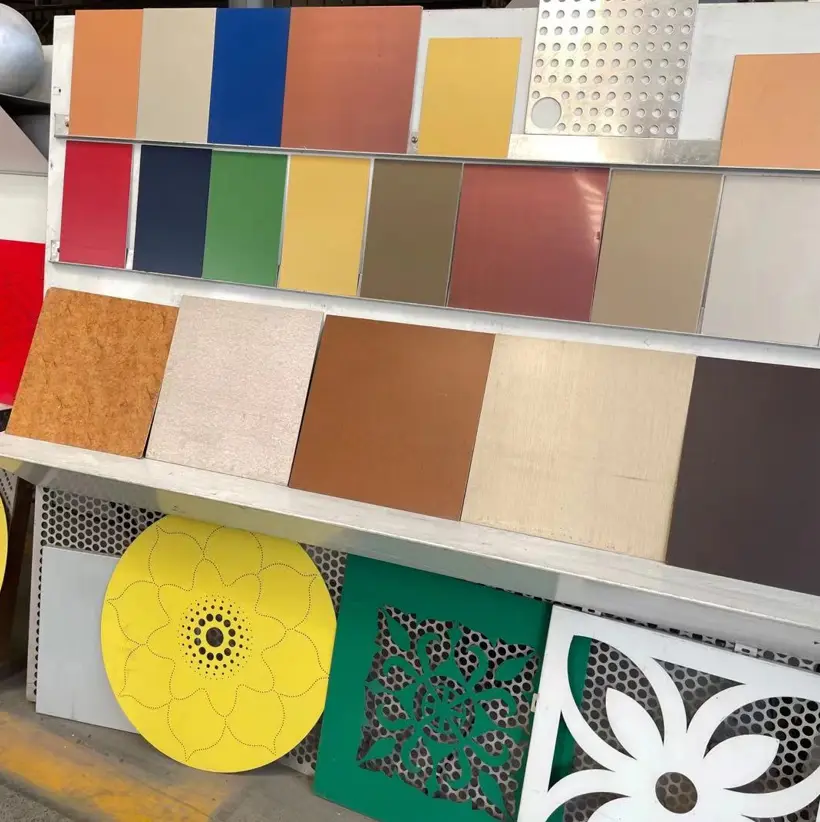
Environmentally sustainable: Aluminum, a recyclable material that can be recycled and reused, reducing the consumption of natural resources. Choosing aluminum pergola helps reduce environmental impact and is in line with the concept of sustainable development.
Aluminum Roll-Up Pergolas: Meet All Your Needs
The traditional aluminum pergola offers a variety of advantages, but due to the impermeable nature of the metal material, you may be concerned that you won’t be able to enjoy the sunshine inside the aluminum pergola, which is certainly unacceptable to those who are looking forward to enjoying their leisure time in the sunshine, but don’t worry, there is a brand new option for aluminum pergola in addition to using the aluminum panels as the roof-Roller pergola roof. This may turn your imagination of pergola upside down.

It’s a retractable roof design that can be opened or closed as often as needed, operated by a manual or electro-mechanical system that allows you to adjust how much the roof opens and closes depending on the weather or your personal preference. When shade or protection is needed, the roof can be closed completely to provide sun and shade. And when sunlight and natural light need to be enjoyed, the roof can be opened fully or partially.
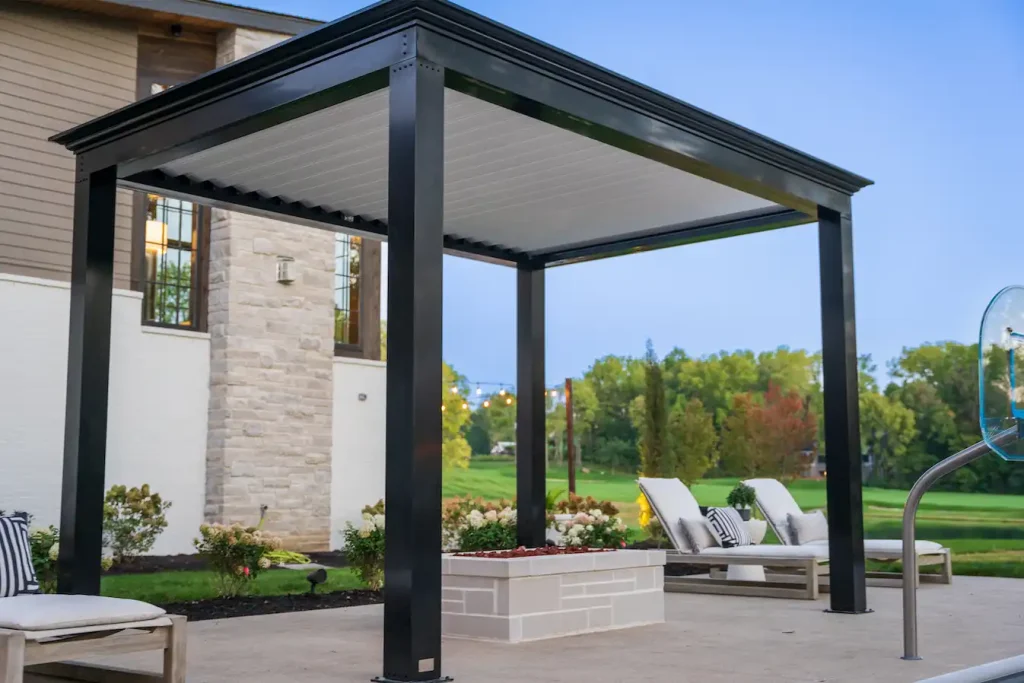
With the same durable and easy-to-clean materials of aluminum, roll-up aluminum roofs can withstand a wide range of weather conditions. The method of operation is also simple. Manual operation or motorized drive are both possible. Manual operation is usually accomplished by means of a rope, handle or crankshaft that requires manual turning.
Electric operation, on the other hand, uses an electric motor and switch that can be used to control the opening and closing of the roof via a remote control or switch button.
Installation and Maintenance: Installation of roll-up aluminum roofs usually requires a professional to ensure structural soundness and operational flexibility.
Regular cleaning and maintenance are also important to keep your roof functional and looking great. Shading materials are washed regularly to ensure they are clean and prevent dust buildup.
In terms of design style, because of the superiority of aluminum materials, such as ease of cutting and painting, you can make láminas de aluminio o bobinas de aluminio into any form you want, as long as you choose the right supplier, ensure the quality of the material, and select the right aluminum series.

Selección del material de aluminio
Las pérgolas de aluminio suelen fabricarse con aluminio de la serie 5000 o de la serie Aluminio serie 6000La serie exacta de aluminio utilizada variará en función del diseño y los requisitos de la pérgola.
En la serie 5000, las aleaciones de aluminio más comunes son 5052 y 5083. Aleación de aluminio 5052 tiene buena resistencia a la corrosión y maleabilidad, y es adecuado para fabricar paneles o carcasas para techos enrollables de aluminio. Aleación de aluminio 5083 tiene una mayor solidez y resistencia a la corrosión, y es adecuado para grandes techos enrollables de aluminio que requieren una mayor resistencia estructural.
Dentro de la serie 6000, las más comunes son 6061 y Aleaciones de aluminio 6063que ofrecen buenas propiedades mecánicas y maquinabilidad para marcos y componentes estructurales de techos enrollables de aluminio. El 6063 se utiliza habitualmente para techos enrollables de aluminio de tamaño pequeño a mediano, mientras que el 6061 se suele emplear para techos enrollables de aluminio de mayor tamaño o que requieren una mayor resistencia.
La elección de la serie de aleación de aluminio que se va a utilizar depende de los requisitos de diseño del techo enrollable de aluminio, el tamaño, el presupuesto y los requisitos de resistencia a la intemperie del entorno en el que se encuentra. Los fabricantes y diseñadores deben tener en cuenta todos estos factores para seleccionar la serie de aleación de aluminio adecuada para satisfacer las necesidades funcionales y de rendimiento de los techos de aluminio enrollables.
Diferencias entre las aleaciones de aluminio
En general, el aluminio y sus aleaciones tienen una gran resistencia a la corrosión. El aluminio puro, conocido comercialmente como aluminio 1xxx, tiene el mayor nivel de resistencia a la corrosión en su estado natural.
Para lograr el rendimiento deseado en varios grupos de aleaciones de aluminio comerciales, la fábrica añade elementos de aleación específicos a la fabricación de aluminio que confieren al metal propiedades específicas como resistencia, ductilidad, soldabilidad, maquinabilidad, resistencia a la corrosión, etc. Como se muestra en el siguiente formulario:
| Grupo Alloy | Elemento principal de aleación | Fuerza | Ductilidad | Resistencia a la corrosión | Soldabilidad | Anodizado |
| Serie 1xxx | Ninguno | Bajo | Alta | Alta | Alta | Alto+ |
| Serie 2xxx | Cu | Alto+ | Bajo | Bajo | Bajo | Bajo |
| Serie 3xxx | Mn | Bajo+ | Alta | Alta | Alta | Alta |
| Serie 5xxx | Mg | Medio | Medio | Alta | Alta | Alta |
| Serie 6xxx | Si/Mg | Medio | Medio | Alta | Alta | Alto+ |
| Serie 7xxx | Zn/Mg | Alta | Bajo | Medio | Medio | Medio |
Aleaciones de aluminio de la serie 1xxx: Aluminio puro o aluminio puro comercial con excelente resistencia a la corrosión y conductividad eléctrica, pero relativamente baja resistencia y propiedades mecánicas. Se utilizan principalmente en aplicaciones en las que la resistencia a la corrosión y la conductividad son críticas, como cables y equipos químicos.
Aleación de aluminio de la serie 2xxx: el principal elemento de aleación es el cobre, que tiene gran resistencia y resistencia al calor, pero poca resistencia a la corrosión.
Aleación de aluminio de la serie 3xxx: El manganeso es el principal elemento de aleación de esta serie. Estas aleaciones tienen buena resistencia, excelente resistencia a la corrosión y conformabilidad moderada. Suelen utilizarse en aplicaciones en las que la resistencia a la corrosión es crítica, como componentes marinos, intercambiadores de calor y equipos de procesamiento químico.
Aleación de aluminio serie 4xxx: el principal elemento de aleación es el silicio, que tiene una excelente fluidez, soldabilidad y resistencia al calor, y se utiliza habitualmente en aplicaciones de soldadura y fundiciones complejas.
Aleación de aluminio de la serie 5xxx: El magnesio es el principal elemento de aleación de esta serie. Estas aleaciones tienen buena conformabilidad, alta resistencia y excelente resistencia a la corrosión, y se utilizan ampliamente en una variedad de industrias, incluidas las aplicaciones de automoción, náutica y construcción. Los usos más comunes incluyen paneles de carrocería de automóviles, cascos y componentes estructurales.
Aleaciones de aluminio de la serie 6xxx: Los principales elementos de aleación son el silicio y el magnesio, que proporcionan un buen equilibrio entre resistencia, conformabilidad y resistencia a la corrosión. Se utilizan ampliamente en aplicaciones como extrusión, componentes estructurales y piezas de automoción, y son aleaciones de aluminio comunes de uso general.
Aleación de aluminio de la serie 7xxx: El principal elemento de aleación es el zinc, que tiene una excelente resistencia y resistencia al calor, y es adecuado para algunas aplicaciones que requieren una mayor resistencia. Como las industrias aeroespacial, de defensa y de artículos deportivos.
Aleación de aluminio de la serie 8xxx: los principales elementos de aleación son el estaño, el litio, con buen rendimiento en el tratamiento térmico y resistencia a la corrosión, conocida por su baja densidad, alta resistencia y excelente resistencia a la fatiga, a menudo utilizada en aplicaciones especiales, como las aeroespaciales, para reducir el peso y mejorar el rendimiento estructural.
Cabe señalar que la comparación del rendimiento de las diferentes aleaciones de aluminio no se limita a las características enumeradas anteriormente, y las propiedades específicas también se ven afectadas por factores como la composición específica de la aleación, el tratamiento térmico y la tecnología de procesamiento. A la hora de seleccionar la aleación de aluminio adecuada, deben considerarse exhaustivamente diversos indicadores de rendimiento en función de las necesidades específicas de la aplicación.


